Detailed Project Charter for Melbourne Future Project Development
VerifiedAdded on 2021/06/18
|7
|1290
|96
Project
AI Summary
This project charter outlines the Melbourne Future Project, a comprehensive initiative by the Melbourne City Council to develop an inclusive city. The project aims to integrate individuals from diverse backgrounds, foster relationships, and promote knowledge sharing. Key deliverables include developing a people-centered city, creating a knowledge hub, promoting arts and culture, and ensuring Aboriginal city preservation. The charter details high-level requirements such as community meetings, training, and stakeholder engagement. It addresses assumptions, constraints (resources and time), and potential risks, including community and political conflicts. Success will be measured by community participation, feedback surveys, and resource efficiency. The project is scheduled from 2018 to 2026, with a budget of $35,000. Stakeholders include the Melbourne State (sponsor), the community, and the government. The Melbourne City Council project team will be responsible for project management, with formal change request and acceptance processes in place.
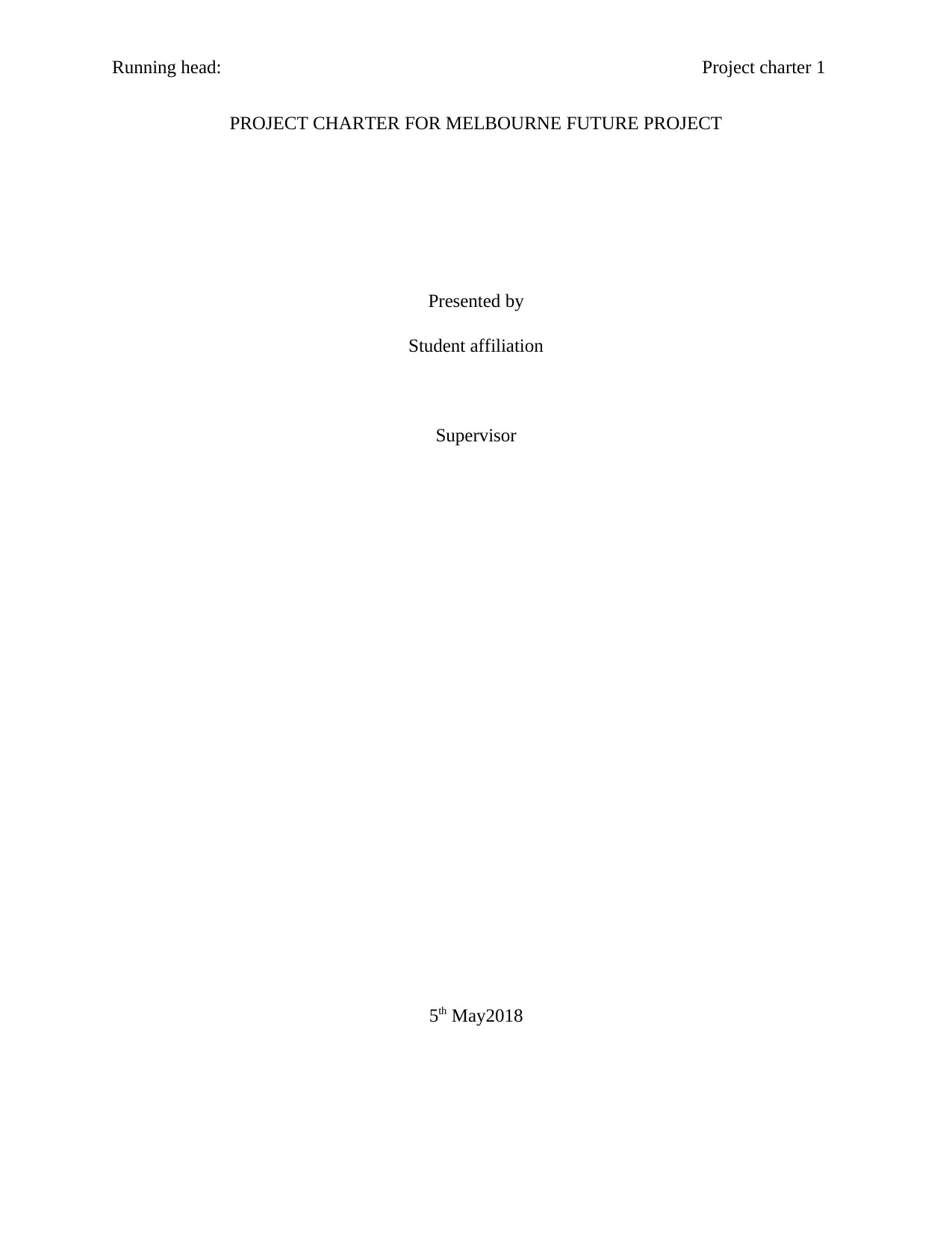
Running head: Project charter 1
PROJECT CHARTER FOR MELBOURNE FUTURE PROJECT
Presented by
Student affiliation
Supervisor
5th May2018
PROJECT CHARTER FOR MELBOURNE FUTURE PROJECT
Presented by
Student affiliation
Supervisor
5th May2018
Paraphrase This Document
Need a fresh take? Get an instant paraphrase of this document with our AI Paraphraser

Running head: Project charter 2
Project descriptions
Project sponsor : Melbourne city state
Project manager: Melbourne city council committee
Project goal: To develop an ‘inclusive city’ for the people of Melbourne city
Project duration: From year 2018 to 2026
Project purpose The purpose of the project is to develop a city in Melbourne
that represents inclusivity of all the people in various sectors.
The committee goal is to plan suitable ways that promote
social integrations and inclusivity. ‘The purpose of the project
will be achieved by changing the policy to accommodate and
embrace inclusivity in various sectors of the city (Burke 2013,
p.34).’
Project justification The project is part of the overall plan of developing Melbourne
city to be a recognized international city in the future. People
are the main development parameters in changing the
appearance of a city. ‘It is necessary initiatives that focus on
individual inclusivity be part of future plans (Hedman 2013,
p.34).’ Implementation of the project will be critical in
ensuring that people from different cultures and backgrounds
are accommodated in the city.
Project objectives The project goal will be achieved by the following objectives:
Developing a city that will integrate individuals from different
backgrounds, to build relationship between individuals local
and across borders, and to enrich sharing knowledge that will
enhance a prosperous city. The objectives are set by the
council of Melbourne to be achieved within a period of 10
years until 2018.
Project key deliverables ‘Deliverables represent key activities that need to be
implemented to ensure the project goal is achieved (Heagney
2016, p.56).’ To ensure inclusivity in the city the key
deliverables will form the specific requirements to ensure the
Project descriptions
Project sponsor : Melbourne city state
Project manager: Melbourne city council committee
Project goal: To develop an ‘inclusive city’ for the people of Melbourne city
Project duration: From year 2018 to 2026
Project purpose The purpose of the project is to develop a city in Melbourne
that represents inclusivity of all the people in various sectors.
The committee goal is to plan suitable ways that promote
social integrations and inclusivity. ‘The purpose of the project
will be achieved by changing the policy to accommodate and
embrace inclusivity in various sectors of the city (Burke 2013,
p.34).’
Project justification The project is part of the overall plan of developing Melbourne
city to be a recognized international city in the future. People
are the main development parameters in changing the
appearance of a city. ‘It is necessary initiatives that focus on
individual inclusivity be part of future plans (Hedman 2013,
p.34).’ Implementation of the project will be critical in
ensuring that people from different cultures and backgrounds
are accommodated in the city.
Project objectives The project goal will be achieved by the following objectives:
Developing a city that will integrate individuals from different
backgrounds, to build relationship between individuals local
and across borders, and to enrich sharing knowledge that will
enhance a prosperous city. The objectives are set by the
council of Melbourne to be achieved within a period of 10
years until 2018.
Project key deliverables ‘Deliverables represent key activities that need to be
implemented to ensure the project goal is achieved (Heagney
2016, p.56).’ To ensure inclusivity in the city the key
deliverables will form the specific requirements to ensure the
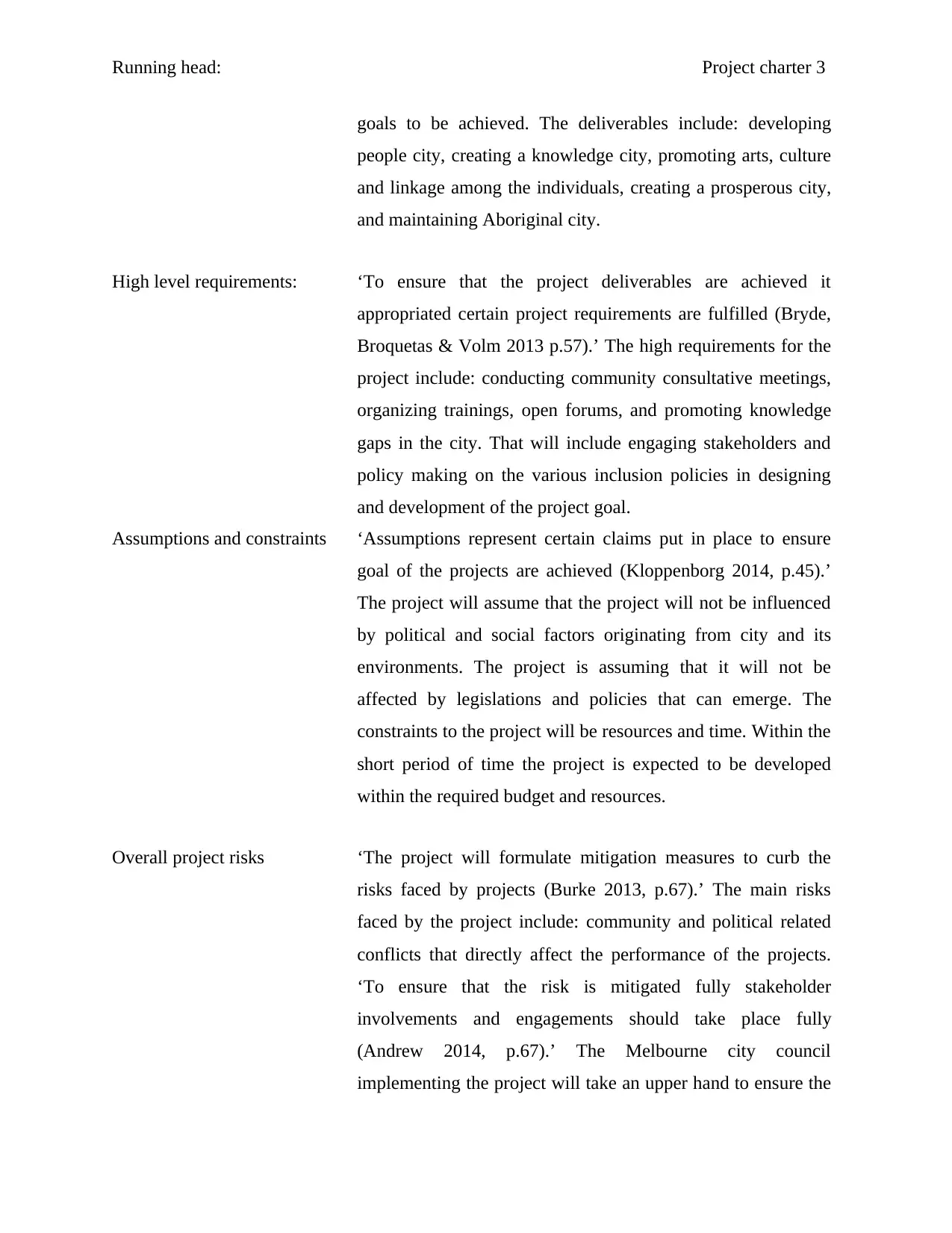
Running head: Project charter 3
goals to be achieved. The deliverables include: developing
people city, creating a knowledge city, promoting arts, culture
and linkage among the individuals, creating a prosperous city,
and maintaining Aboriginal city.
High level requirements: ‘To ensure that the project deliverables are achieved it
appropriated certain project requirements are fulfilled (Bryde,
Broquetas & Volm 2013 p.57).’ The high requirements for the
project include: conducting community consultative meetings,
organizing trainings, open forums, and promoting knowledge
gaps in the city. That will include engaging stakeholders and
policy making on the various inclusion policies in designing
and development of the project goal.
Assumptions and constraints ‘Assumptions represent certain claims put in place to ensure
goal of the projects are achieved (Kloppenborg 2014, p.45).’
The project will assume that the project will not be influenced
by political and social factors originating from city and its
environments. The project is assuming that it will not be
affected by legislations and policies that can emerge. The
constraints to the project will be resources and time. Within the
short period of time the project is expected to be developed
within the required budget and resources.
Overall project risks ‘The project will formulate mitigation measures to curb the
risks faced by projects (Burke 2013, p.67).’ The main risks
faced by the project include: community and political related
conflicts that directly affect the performance of the projects.
‘To ensure that the risk is mitigated fully stakeholder
involvements and engagements should take place fully
(Andrew 2014, p.67).’ The Melbourne city council
implementing the project will take an upper hand to ensure the
goals to be achieved. The deliverables include: developing
people city, creating a knowledge city, promoting arts, culture
and linkage among the individuals, creating a prosperous city,
and maintaining Aboriginal city.
High level requirements: ‘To ensure that the project deliverables are achieved it
appropriated certain project requirements are fulfilled (Bryde,
Broquetas & Volm 2013 p.57).’ The high requirements for the
project include: conducting community consultative meetings,
organizing trainings, open forums, and promoting knowledge
gaps in the city. That will include engaging stakeholders and
policy making on the various inclusion policies in designing
and development of the project goal.
Assumptions and constraints ‘Assumptions represent certain claims put in place to ensure
goal of the projects are achieved (Kloppenborg 2014, p.45).’
The project will assume that the project will not be influenced
by political and social factors originating from city and its
environments. The project is assuming that it will not be
affected by legislations and policies that can emerge. The
constraints to the project will be resources and time. Within the
short period of time the project is expected to be developed
within the required budget and resources.
Overall project risks ‘The project will formulate mitigation measures to curb the
risks faced by projects (Burke 2013, p.67).’ The main risks
faced by the project include: community and political related
conflicts that directly affect the performance of the projects.
‘To ensure that the risk is mitigated fully stakeholder
involvements and engagements should take place fully
(Andrew 2014, p.67).’ The Melbourne city council
implementing the project will take an upper hand to ensure the
⊘ This is a preview!⊘
Do you want full access?
Subscribe today to unlock all pages.

Trusted by 1+ million students worldwide
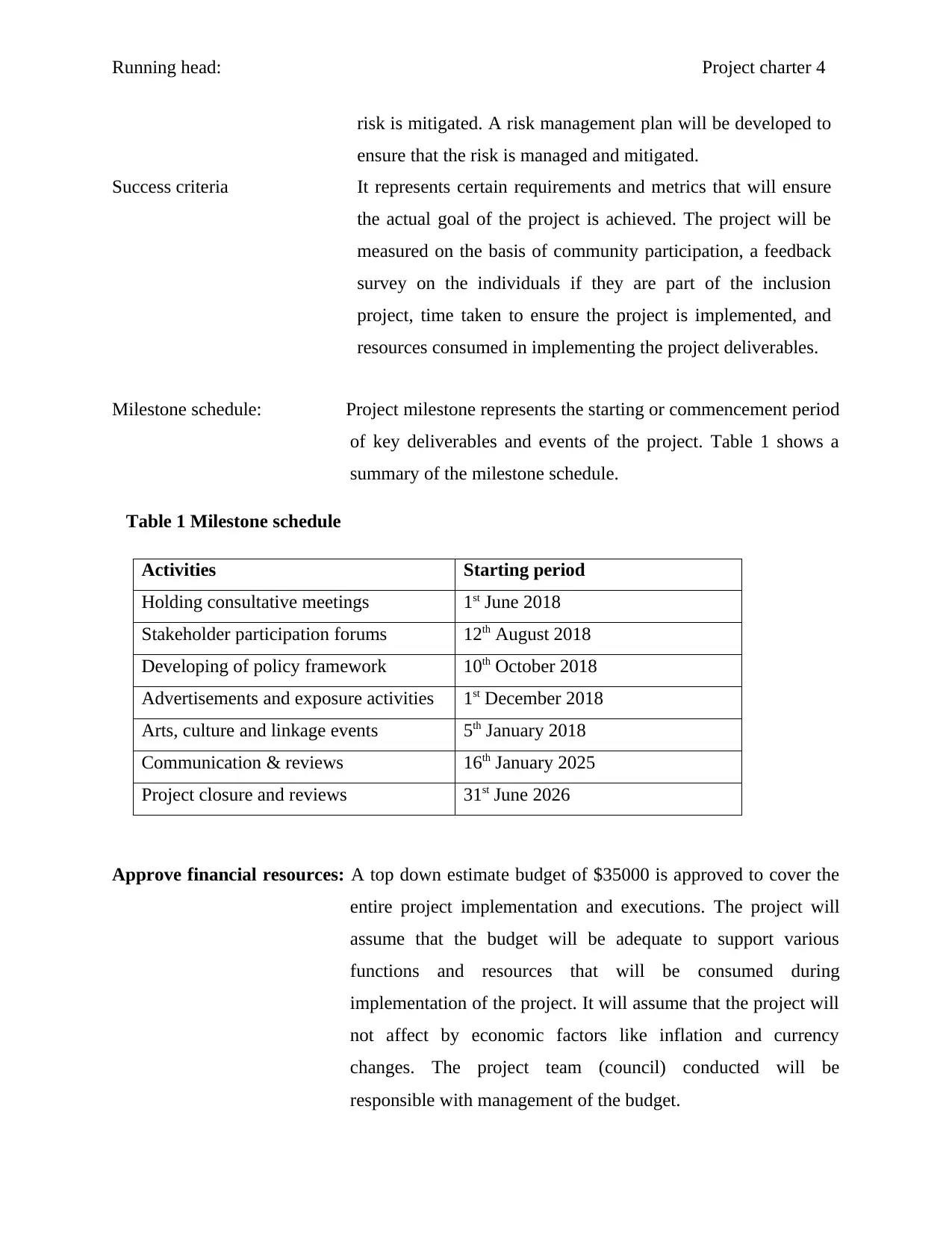
Running head: Project charter 4
risk is mitigated. A risk management plan will be developed to
ensure that the risk is managed and mitigated.
Success criteria It represents certain requirements and metrics that will ensure
the actual goal of the project is achieved. The project will be
measured on the basis of community participation, a feedback
survey on the individuals if they are part of the inclusion
project, time taken to ensure the project is implemented, and
resources consumed in implementing the project deliverables.
Milestone schedule: Project milestone represents the starting or commencement period
of key deliverables and events of the project. Table 1 shows a
summary of the milestone schedule.
Table 1 Milestone schedule
Activities Starting period
Holding consultative meetings 1st June 2018
Stakeholder participation forums 12th August 2018
Developing of policy framework 10th October 2018
Advertisements and exposure activities 1st December 2018
Arts, culture and linkage events 5th January 2018
Communication & reviews 16th January 2025
Project closure and reviews 31st June 2026
Approve financial resources: A top down estimate budget of $35000 is approved to cover the
entire project implementation and executions. The project will
assume that the budget will be adequate to support various
functions and resources that will be consumed during
implementation of the project. It will assume that the project will
not affect by economic factors like inflation and currency
changes. The project team (council) conducted will be
responsible with management of the budget.
risk is mitigated. A risk management plan will be developed to
ensure that the risk is managed and mitigated.
Success criteria It represents certain requirements and metrics that will ensure
the actual goal of the project is achieved. The project will be
measured on the basis of community participation, a feedback
survey on the individuals if they are part of the inclusion
project, time taken to ensure the project is implemented, and
resources consumed in implementing the project deliverables.
Milestone schedule: Project milestone represents the starting or commencement period
of key deliverables and events of the project. Table 1 shows a
summary of the milestone schedule.
Table 1 Milestone schedule
Activities Starting period
Holding consultative meetings 1st June 2018
Stakeholder participation forums 12th August 2018
Developing of policy framework 10th October 2018
Advertisements and exposure activities 1st December 2018
Arts, culture and linkage events 5th January 2018
Communication & reviews 16th January 2025
Project closure and reviews 31st June 2026
Approve financial resources: A top down estimate budget of $35000 is approved to cover the
entire project implementation and executions. The project will
assume that the budget will be adequate to support various
functions and resources that will be consumed during
implementation of the project. It will assume that the project will
not affect by economic factors like inflation and currency
changes. The project team (council) conducted will be
responsible with management of the budget.
Paraphrase This Document
Need a fresh take? Get an instant paraphrase of this document with our AI Paraphraser
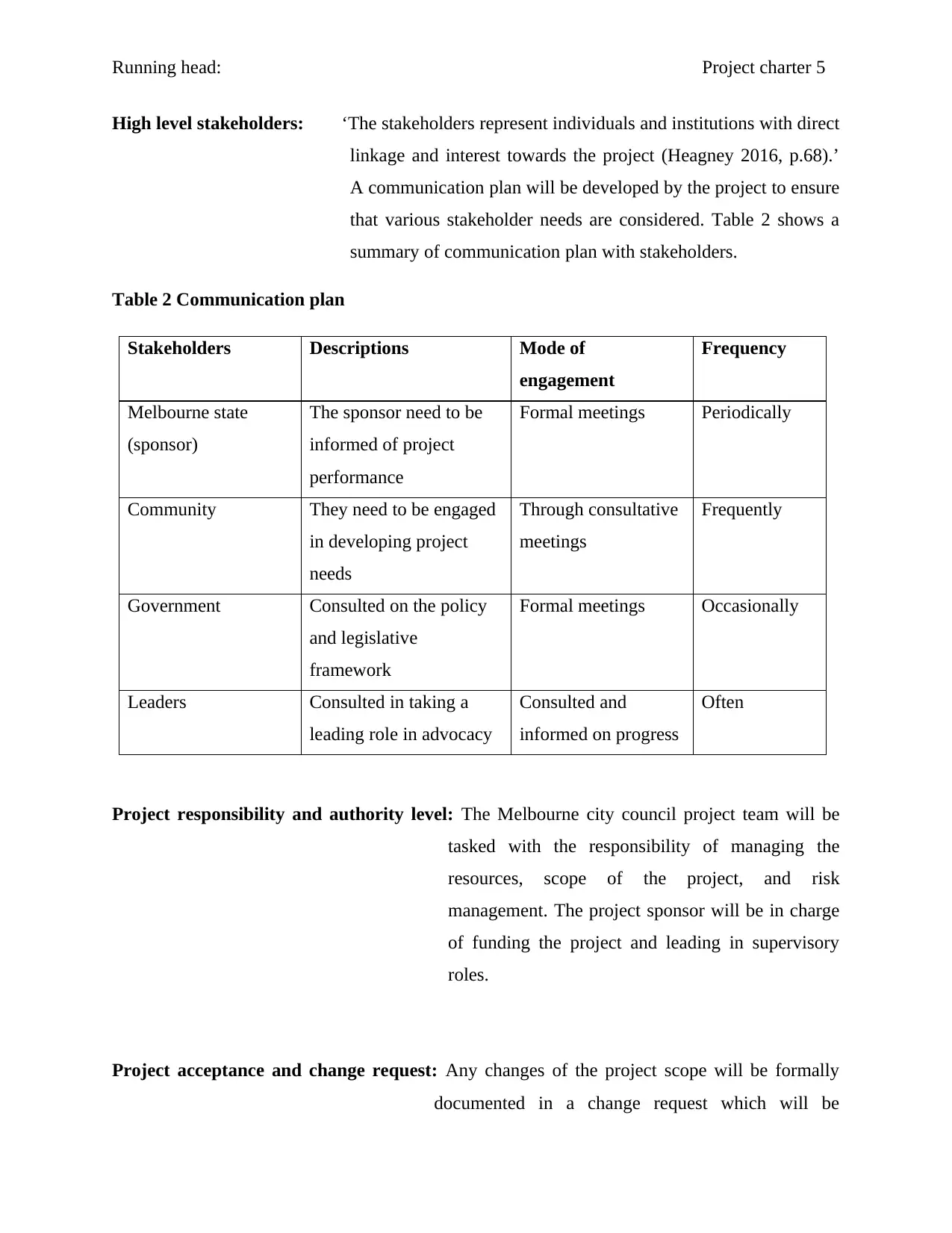
Running head: Project charter 5
High level stakeholders: ‘The stakeholders represent individuals and institutions with direct
linkage and interest towards the project (Heagney 2016, p.68).’
A communication plan will be developed by the project to ensure
that various stakeholder needs are considered. Table 2 shows a
summary of communication plan with stakeholders.
Table 2 Communication plan
Stakeholders Descriptions Mode of
engagement
Frequency
Melbourne state
(sponsor)
The sponsor need to be
informed of project
performance
Formal meetings Periodically
Community They need to be engaged
in developing project
needs
Through consultative
meetings
Frequently
Government Consulted on the policy
and legislative
framework
Formal meetings Occasionally
Leaders Consulted in taking a
leading role in advocacy
Consulted and
informed on progress
Often
Project responsibility and authority level: The Melbourne city council project team will be
tasked with the responsibility of managing the
resources, scope of the project, and risk
management. The project sponsor will be in charge
of funding the project and leading in supervisory
roles.
Project acceptance and change request: Any changes of the project scope will be formally
documented in a change request which will be
High level stakeholders: ‘The stakeholders represent individuals and institutions with direct
linkage and interest towards the project (Heagney 2016, p.68).’
A communication plan will be developed by the project to ensure
that various stakeholder needs are considered. Table 2 shows a
summary of communication plan with stakeholders.
Table 2 Communication plan
Stakeholders Descriptions Mode of
engagement
Frequency
Melbourne state
(sponsor)
The sponsor need to be
informed of project
performance
Formal meetings Periodically
Community They need to be engaged
in developing project
needs
Through consultative
meetings
Frequently
Government Consulted on the policy
and legislative
framework
Formal meetings Occasionally
Leaders Consulted in taking a
leading role in advocacy
Consulted and
informed on progress
Often
Project responsibility and authority level: The Melbourne city council project team will be
tasked with the responsibility of managing the
resources, scope of the project, and risk
management. The project sponsor will be in charge
of funding the project and leading in supervisory
roles.
Project acceptance and change request: Any changes of the project scope will be formally
documented in a change request which will be
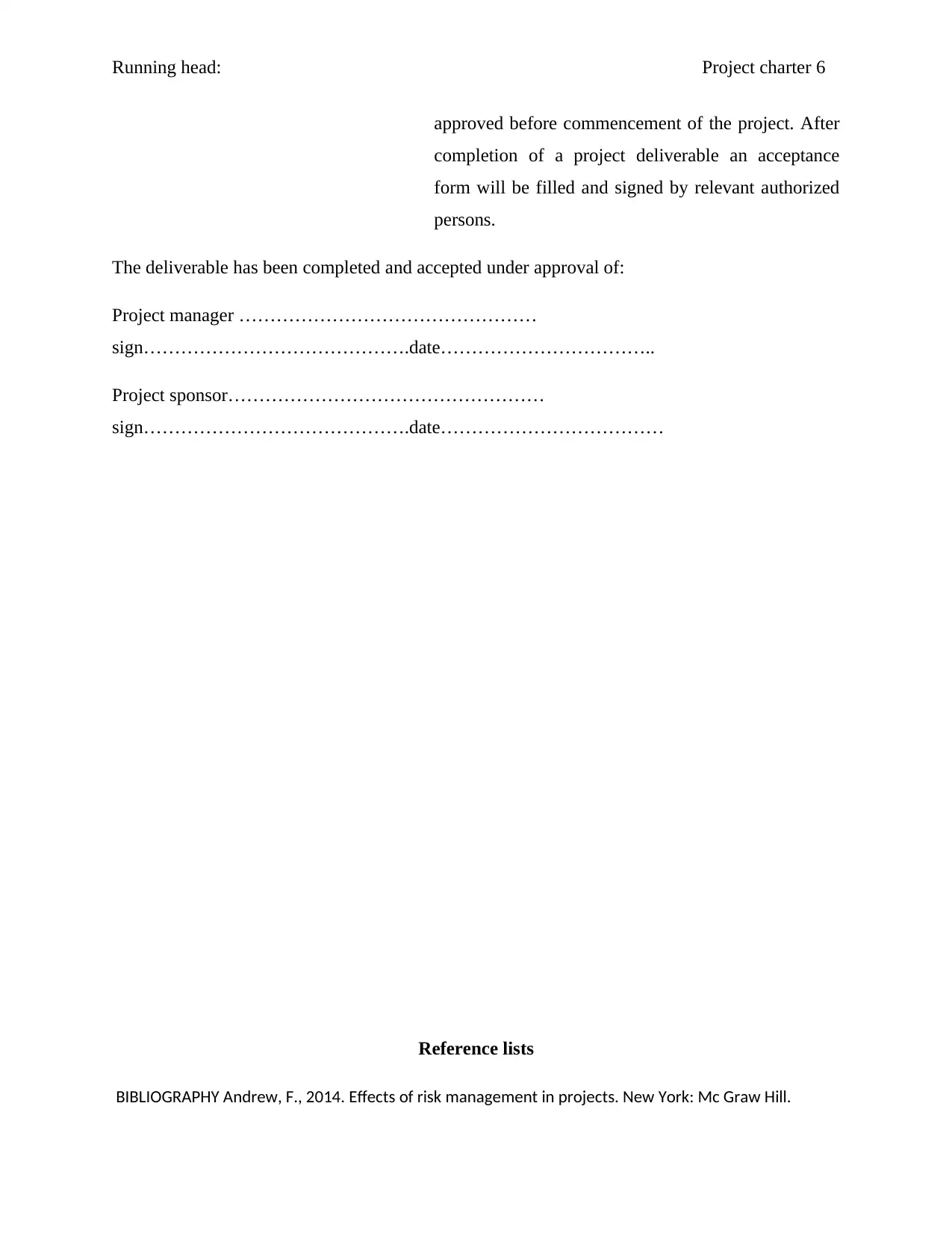
Running head: Project charter 6
approved before commencement of the project. After
completion of a project deliverable an acceptance
form will be filled and signed by relevant authorized
persons.
The deliverable has been completed and accepted under approval of:
Project manager …………………………………………
sign…………………………………….date……………………………..
Project sponsor……………………………………………
sign…………………………………….date………………………………
Reference lists
BIBLIOGRAPHY Andrew, F., 2014. Effects of risk management in projects. New York: Mc Graw Hill.
approved before commencement of the project. After
completion of a project deliverable an acceptance
form will be filled and signed by relevant authorized
persons.
The deliverable has been completed and accepted under approval of:
Project manager …………………………………………
sign…………………………………….date……………………………..
Project sponsor……………………………………………
sign…………………………………….date………………………………
Reference lists
BIBLIOGRAPHY Andrew, F., 2014. Effects of risk management in projects. New York: Mc Graw Hill.
⊘ This is a preview!⊘
Do you want full access?
Subscribe today to unlock all pages.

Trusted by 1+ million students worldwide

Running head: Project charter 7
Bourne, L.,2015. Making projects work:effective stakeholder and communication management.
New Delhi: CRC press.
Bryde, Broquetas & Volm .,2013. The project benefits of building information modelling.
International Journal of project management, 31(7), 971-980.
Burke, R., 2013. Project management: planning and control tecniques. New Jersey: Wiley
publishers.
Heagney, J.,2016. Fundamentals of project management. AMACOM: American management
association.
Hedman, K., 2013. Project management professional exam study guide. Indianapolis: Wiley.
Kendrick, T., 2013. The project management tool kit: 100 tips and techniques for getting the job
done right. . AMACOM Div: American management Assn.
Kloppenborg, T., 2014. Contemporary project management. London: Nelson Education.
Bourne, L.,2015. Making projects work:effective stakeholder and communication management.
New Delhi: CRC press.
Bryde, Broquetas & Volm .,2013. The project benefits of building information modelling.
International Journal of project management, 31(7), 971-980.
Burke, R., 2013. Project management: planning and control tecniques. New Jersey: Wiley
publishers.
Heagney, J.,2016. Fundamentals of project management. AMACOM: American management
association.
Hedman, K., 2013. Project management professional exam study guide. Indianapolis: Wiley.
Kendrick, T., 2013. The project management tool kit: 100 tips and techniques for getting the job
done right. . AMACOM Div: American management Assn.
Kloppenborg, T., 2014. Contemporary project management. London: Nelson Education.
1 out of 7
Related Documents
Your All-in-One AI-Powered Toolkit for Academic Success.
+13062052269
info@desklib.com
Available 24*7 on WhatsApp / Email
![[object Object]](/_next/static/media/star-bottom.7253800d.svg)
Unlock your academic potential
Copyright © 2020–2025 A2Z Services. All Rights Reserved. Developed and managed by ZUCOL.



